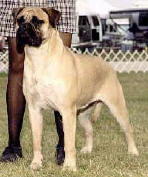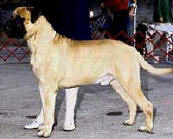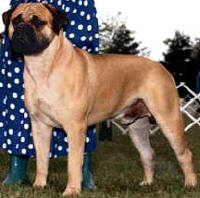|
 BullmastiffInfo.org: Tells us about the origination of your
kennel. What was the driving factor that got you involved with the
Bullmastiff Breed? BullmastiffInfo.org: Tells us about the origination of your
kennel. What was the driving factor that got you involved with the
Bullmastiff Breed?
HappyLegs: HappyLegs began as the combination of two prominent eastern kennels
of the time, Bandog and Jubilee. We were looking for dogs that were
first of all, sound in body and mind, moderate in type and within
the standard in size. We started breeding ďfrom the rear forwardĒ
and developed a bloodline of unexaggerated dogs known for exception
movement.
We got
involved with bullmastiffs absolutely the wrong way. We were living
in a suburb of Detroit and had been robbed, and as Alan was away
from home a great deal, were looking for a dog that would make me
feel ďsafe.Ē We purchased a pet dog from the newspaper, a small,
hyper, although delightful dog. We started to go to dog shows and
decided that our next bullmastiff would be a show dog. Our pet dog
died at two years of age; we purchased our first show dog shortly
after his death and have been hooked on the sport ever since.
BullmastiffInfo.org: Some kennels are striving to create their own
bloodline. Is this one of your goals as well? What is involved
with creating such a legacy as your own bloodline?
HappyLegs: Developing your own bloodline means that you are breeding for the
future, not for a litter. It means that you have decided what
qualities of the breed are important to you, and you breed for those
qualities in every litter. When you have developed your own
bloodline, you know the history of most of the dogs in the pedigree,
you know what faults that may be lurking, and the qualities you want
to ďstamp in.Ē You are also aware of any health issues that may be
of concern and do your best to breed around them. When you have your
own bloodline, you have a better understanding of what one of your
puppies may turn out to be, and are better able to assess their
quality and temperament.
BullmastiffInfo.org: The Bullmastiff is one of few breeds whose
physical characteristics can vary dramatically from one kennel to
the next. The head shape of the Bullmastiff is a prime example of
this. Although all seem to fall within the basis of the Bullmastiff
standard - there is still a considerable and noticeable difference
to the layman's eye. Do you think this is acceptable and serves as a
signature look for a particular kennel/bloodline? Or is this an
item of improvement for the Bullmastiff breeding program to move
towards a more consistent looking Bullmastiff across all kennels?
HappyLegs: Because of its origins, as a combination of the bulldog and the
mastiff, the bullmastiff is a breed that doesnít breed true. This
means that even in a linebred litter, you will get variations in
type. I believe the current standard addresses that, and is
therefore fairly loose in its description of the breed. I think that
this is both a good and bad thing. The negative is what was
addressed, that it allows for a wide variation in how the dogs may
look. However, on the positive side, it allows a breeder to develop
his or her own interpretation of the standard, and to put his or her
own ďmarkĒ on the breed. While there are certain parts of the
standard that are not open to interpretation (squareness being one,
my own personal pet peeve!) it also allows individual breeders to
develop a distinctive line of bullmastiffs.
BullmastiffInfo.org: With the cost of a Bullmastiff puppy being
higher than most other breeds, most people would think that breeding
Bullmastiffs is a lucrative and easy endeavor. Is this true?
HappyLegs: If
only it were so! I am certain there are people who make money
breeding bullmastiffs, but they most likely do not show their dogs,
nor perform standard health checks on their breeding stock or sell
their puppies with basic guarantees. While many may bemoan the show
ring as political and unfair, it is, at this point, the only way
breeders can compare their dogs and see where their strengths are
and what needs to be improved. Bullmastiffs are costly to breed, and
if one breeds on a fairly regular basis, even breaking even is
rarely possible.
BullmastiffInfo.org: Specifically what do you consider to be the
most difficult part about breeding Bullmastiffs?
HappyLegs: This
is a heartbreak breed. There are many difficulties in breeding,
whelping and keeping puppies alive, and you have to have a pretty
tough constitution in order to survive over the long haul. Just when
I think I have seen every possible problem, I am struck with
another. This is a guard breed, and while there are many
well-intentioned folks out there, many of them are just not suited
for this breed. You have to be able to sort them out. You can also
never forget that the original bullmastiff was a much tougher dog,
which means that no matter how careful you are in selecting and
researching your breeding stock, you are going to produce some
puppies with unsuitable temperaments for today's lifestyles. Anyone
who thinks that this is not going to happen is not being realistic
about the breed. It is also imperative to try and keep in contact
with everyone you sell a puppy to, which means always being on call
to give advice, answer questions, and take a dog back for whatever
reason. Breeding bullmastiffs is a huge commitment, and it is not
something that should be taken lightly.
BullmastiffInfo.org: What do you consider to be the most difficult
part about participating in the professional circuit in regards to
conformation?
HappyLegs: Staying objective. I believe the problem most people have is, quite
honestly, they always feel their dog should win and are unhappy or
even upset when it does not. Like anything else, dog shows can be
political. If you show your dog, you have to go in to it
understanding that. If you have a good dog, itís going to win more
than itís going to lose, or itís going to win enough. If you think
you have a good dog and itís not winning, there will come a point
where you just canít say itís political. You have to take a hard
look at your dog and see whatís wrong with it. Instead of getting
mad and leaving when your dog loses, stay and find out why your dog
lost, and what kind of dog won. Stay and watch the breed and the
group. Showing in conformation is a great opportunity to learn about
your dog, the breed, and dogs in general. Donít pass it up!
BullmastiffInfo.org: Compared to other dog breeds, the Bullmastiff
is still rarely seen in the agility ring - even though ownership of
the Bullmastiff has increased dramatically. Why do you think there
are still so few Bullmastiffs participating is this particular
sector?
HappyLegs: Certainly the size, stamina and the tendency for dog aggression in
this breed contribute to the lack of participation. While I do not
show in agility, from what I have seen, the small, undersized,
energetic bitches are the most successful. Bullmastiffs are not made
for agility or obedience; you have to want to do it badly and have a
dog that wishes to please you, which is not the typical temperament
of this breed.
....continue.... |
BullmastiffInfo.org: As the popularity of Bullmastiff ownership
rises, so are the incidents of children getting bitten by
Bullmastiffs. With the media heavily publicizing dog attacks of any
nature - it has potential to bring an undesirable reputation to this
breed. How compatible do you think the Bullmastiff breed (as a
whole - not specifically from your kennel) is with young children
and babies?
HappyLegs: Personally, I donít think the bullmastiff is a great breed for homes
with small children. The families must commit to having a guard
breed and take the necessary precautions, and the dog must have the
correct temperament for that particular situation. Most families are
too busy or unwilling to make that kind of commitment. A female
bullmastiff is usually a better choice than a male, but it isnít
always the best choice. I donít have children, so I am uncomfortable
placing a dog in a home with children unless I am absolutely
convinced it is going to work out.
BullmastiffInfo.org: What do you believe may be the reason for the
increased incidents of Bullmastiffs, in particular, biting children?
HappyLegs: I
believe most biting incidents occur because either a family acquires
a bullmastiff with a temperament unsuited for their lifestyle, or
that the family is not willing to make the commitment and take the
precautions necessary for having a guard breed. Families are busy
today, and often the adults do not take the time to ensure that the
bullmastiff understand its place in the household, which is under
every human being in that household, including children. A
bullmastiff that does not have that understanding is a time bomb
waiting to go off. As a bullmastiff will protect its children, it is
imperative that it never be left without adult supervision around
other peopleís children. That is a hard rule to follow in an active
household. Owning a bullmastiff is a liability, especially in a home
with kids. A family has to understand that before taking on this
breed, no matter how sweet a puppy may appear to be.
BullmastiffInfo.org: Are there any cautions you would recommend for
new Bullmastiff owners with children and/or who plan to have
children in the future after acquiring a Bullmastiff to prevent dog
bites?
Only acquire a bullmastiff if
you want a guard breed and are willing to make the commitment
necessary to ensure the dog knows its place in the household.
Socialize the dog as much as possible and, again, make sure it
understands who is in charge. Never leave a bullmastiff unsupervised
with other peopleís children. Do not allow children to bother the
dog when it is obvious it does not want to be bothered; make sure it
has its own space which is off limits to kids. Do not wrestle, play
tug-of war or any other aggression inducing games with the dog. Do
not spoil or baby the dog; treat it with the respect a guard breed
deserves. If you are not interested in the bullmastiff for its
guarding abilities, then get a different, more child-friendly breed
of dog.
I do not want to give the
impression that those with children should absolutely not get a
bullmastiff. There are hundreds of homes in which children and
bullmastiffs live together in harmony. But these are homes in which
the temperament of the bullmastiff, male or female, is suitable to
the lifestyle of the family, and it is also a home in which the
parents have made certain that the bullmastiff has been raised and
trained properly and that the children treat it with respect.
 BullmastiffInfo.org: Many families still hold the old tradition
that large dogs should be kept as outside only pets. Do you think
the Bullmastiff is well suited to be kept as an "outside dog"? BullmastiffInfo.org: Many families still hold the old tradition
that large dogs should be kept as outside only pets. Do you think
the Bullmastiff is well suited to be kept as an "outside dog"?
HappyLegs: In
order to be a reliable guardian, the bullmastiff needs to be
socialized and around people as much as possible. That is not going
to happen if the dog is left outside for the majority of the time.
If you do not wish to have a large, sometimes drooly dog in your
home, then do not get a bullmastiff.
BullmastiffInfo.org: As with any other canine breed, the
Bullmastiff is known to have a variety of health problems. When
these problems arise, the adopting family is left with the cost of
treating these health problems. Should the Bullmastiff Breeder they
purchased the Bullmastiff from bear any responsibility as well? Or
is this something that the Bullmastiff puppy buyer should already be
aware that this is a "side effect" of owning a Bullmastiff and it
will be their full responsibility to deal with any health issues
that may arise?
HappyLegs: I
personally believe that the breeder should be responsible for costs
up to the purchase price of the dog for health issues believed to be
congenital, at least for the first year. All other medical costs
should be the responsibility of the owner
BullmastiffInfo.org: What future would you like to see happen with
the Bullmastiff breed in general? Do you think it this future is
reachable?
HappyLegs: I hope
that those who chose to breed the bullmastiff do so with the
understanding of the enormity of the task they are undertaking. I
hope that those who let a bullmastiff into their home make for it a
proper place where it will be respected, but in which improper
behavior will not be tolerated. I hope that all of us, breeders and
owners, will leave the bullmastiff better than we found it.
Closing Thoughts:
HappyLegs: The
longer I am in this breed, the more I love and respect the
bullmastiff and realize that it is not the breed for everyone. In
the right hands and with the proper respect and treatment, it is
truly a marvelous breed. As a breeder, I hope to leave a legacy of
sound, healthy dogs of correct conformation, exceptional movement
and proper temperament.

BullmastiffInfo.org:
BullmastiffInfo.org would like to
personally thank HappyLegs Bullmastiffs for taking the time to share
their thoughts and experience with our readers! If you would
like more information about HappyLegs Bullmastiffs from Chris
Lezotte and Alan Kalter, contact them at:
HappyLegs
Bullmastiffs
Chris Lezotte & Alan Kalter
Ann Arbor, Michigan
Website:
www.happylegsbmf.com
e-mail
happylegs@provide.net
(734) 741-7326.
 |